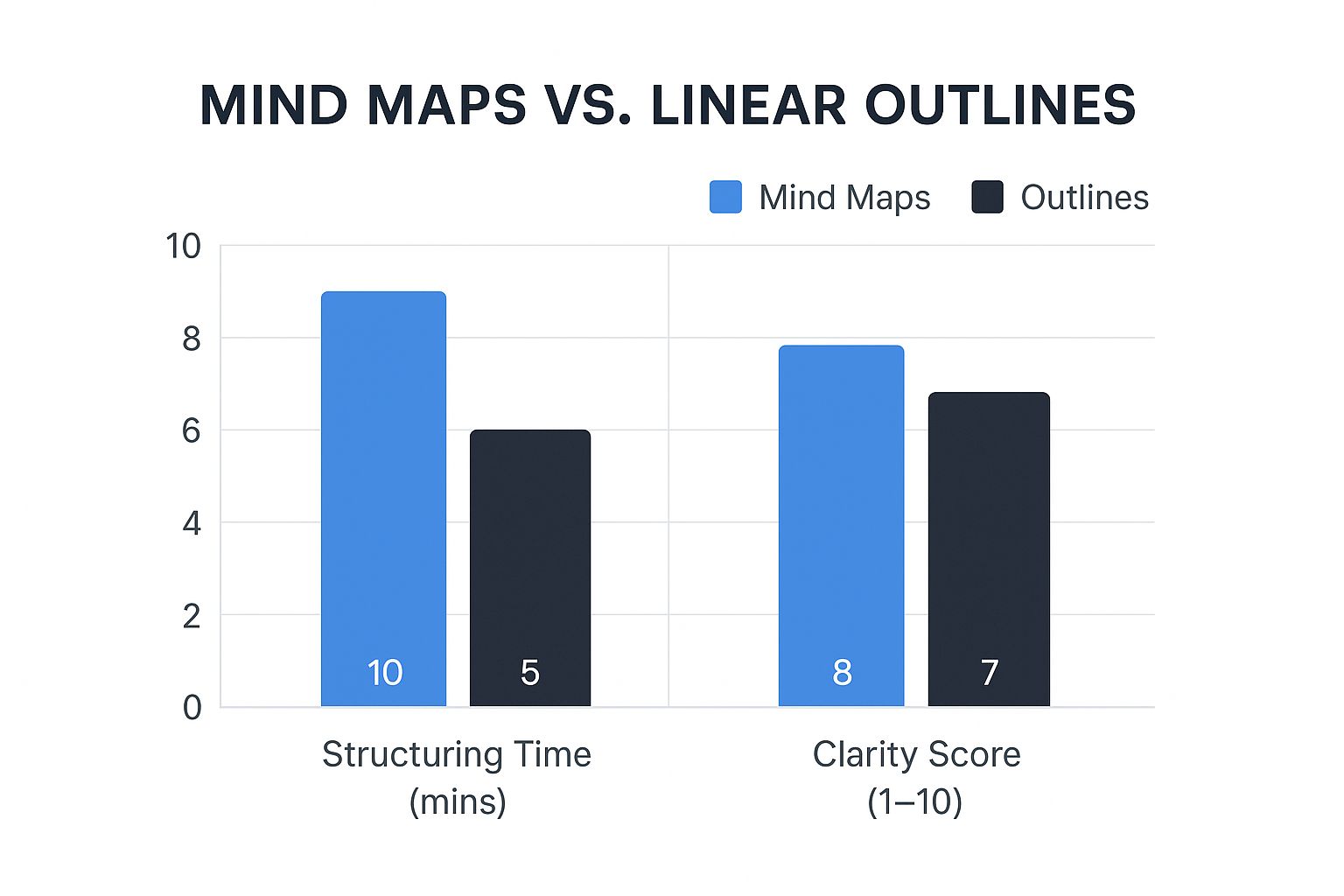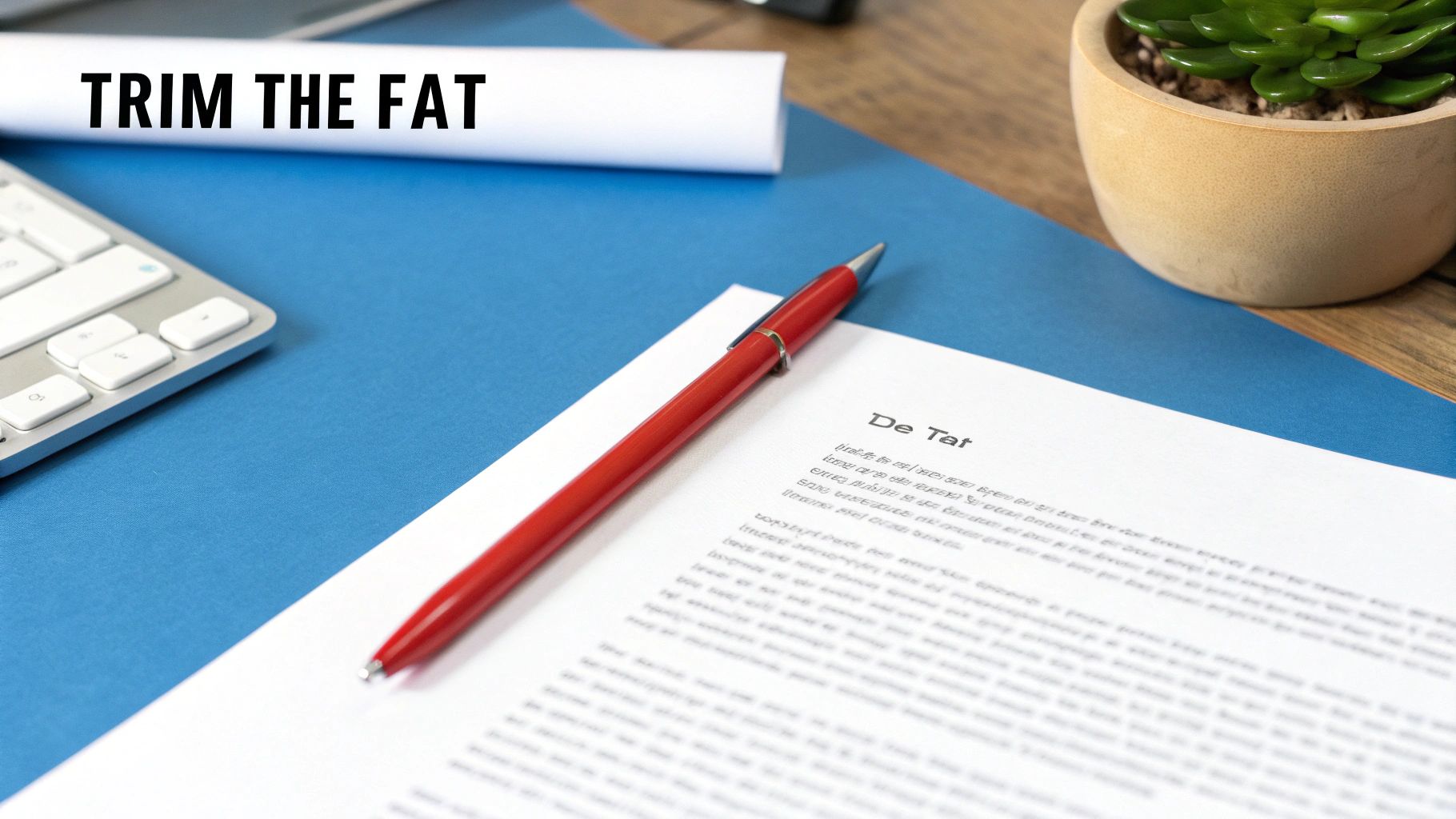The Hidden Power of Clear and Concise Writing

We live in a world overflowing with information. The ability to communicate clearly and concisely is now a critical advantage, not just a desirable skill. This is especially important for students balancing assignments, projects, and extracurriculars. This section explores why clarity and conciseness are essential for communication and academic success.
Why Clarity Matters
The human brain thrives on simplicity. Like a computer bogged down by complex code, our minds struggle with convoluted writing. This extra effort reduces comprehension and increases cognitive load. Clear writing, however, fosters understanding and engagement by creating an immediate connection with the reader.
Imagine a dense textbook paragraph filled with jargon compared to a well-structured explanation with simple language and examples. Which is easier to grasp and remember? This principle applies to all communication, from academic papers to emails.
The Business Impact of Clear Writing
The value of clear and concise writing extends beyond academics and into the professional world. Companies like Apple and Google prioritize clear communication. They understand that clear messaging improves engagement, decision-making, and persuasive outcomes, especially in fast-paced business environments.
Concise scientific writing also has a greater impact. Studies show that readers recall information more effectively when it’s presented concisely, highlighting the importance of clear communication in scientific writing for reader engagement and understanding. Learn more about this topic.
Conciseness: A Competitive Edge
Conciseness makes every word count, maximizing impact with minimal text. In our digital age of short attention spans, brevity is key. Communicating quickly and efficiently is crucial for capturing and holding your audience's attention.
Think about a long, rambling email versus a short, focused message. The latter respects the reader's time and is more likely to get a positive response. This is why concise writing offers a significant advantage. By writing clearly and concisely, you can communicate effectively, boost your academic performance, and prepare for career success.
Cutting The Clutter: Practical Techniques for Streamlining

The chart above illustrates how time spent structuring content impacts clarity. While linear outlines are faster, mind maps produce a higher clarity score. This underscores the importance of selecting the right pre-writing method. A mind map, for example, can be invaluable for complex arguments, ensuring a logical flow even if it requires more initial time investment.
Identifying Unnecessary Words
First drafts are often filled with extra words. Recognizing and removing these words is key to clear and concise writing. This means cutting redundancies, such as "past history" or "absolutely essential." It also means avoiding qualifier bloat, where words like "very," "really," and "quite" diminish impact. Removing them strengthens your message.
The following table provides a helpful overview of common writing problems and their solutions. It illustrates how seemingly small changes can dramatically improve the clarity and effectiveness of your writing.
Common Writing Problems and Their Solutions
| Writing Problem | Example | Clear Alternative | Improvement |
|---|---|---|---|
| Redundancy | Past history | History | More concise, avoids repetition |
| Redundancy | Absolutely essential | Essential | Stronger and more direct |
| Qualifier Bloat | Very important | Important | More impactful, avoids weakening the adjective |
| Nominalization | Conduct an investigation | Investigate | More active and engaging verb usage |
This table emphasizes the benefits of replacing wordy phrases with concise alternatives. By focusing on strong verbs and eliminating redundancies, your writing becomes more impactful and easier to understand.
Streamlining Your Sentences
Professional editors employ various strategies for concise sentences. Replacing weak verbs with stronger alternatives is one method. Using "decide" instead of "make a decision" creates tighter, more impactful prose. Addressing nominalizations, where verbs are turned into nouns (e.g., "conduct an investigation" vs. "investigate"), simplifies language and improves engagement. Concise writing, as demonstrated in resources like improving internal communication, is also crucial for effective teamwork.
Applying Concise Writing Principles in Different Contexts
Clarity and conciseness requirements differ depending on the context. Technical documents, for instance, may require specific language for clarity, even if it results in slightly longer sentences. Marketing copy, on the other hand, prioritizes concise, engaging language to drive conversions. Clear, concise writing is also essential in business reports. A 2020 Harvard Business Review survey showed that 86% of executives valued clarity and 75% preferred concise reports. This extends to academic writing, too. Further information is available on the importance of concise writing in reports and effective summarization techniques.
Architecting Clear Ideas: The Skeleton of Effective Writing

Clarity and conciseness are essential for effective writing. These qualities don't appear magically; they are the product of deliberate planning and structuring. This section explores how to organize your thoughts before writing, creating a solid foundation for clear and concise communication.
Pre-Writing Techniques for Logical Flow
Just as an architect creates blueprints, writers should blueprint their ideas. This pre-writing phase is vital to prevent rambling and ensure a logical flow. Several techniques can help. Mind mapping, for instance, lets you visually brainstorm and connect ideas, revealing hidden relationships and hierarchies. Using keyboard shortcuts can also help streamline your writing process.
Another useful technique is structured outlining. This involves creating a hierarchical list of main points and supporting arguments, providing a clear roadmap for your writing and ensuring each idea builds upon the last. For narrative or persuasive writing, storyboarding can be especially helpful, allowing you to visualize the flow of your story or argument.
Progressive Disclosure: Building Understanding Step by Step
Effective writers use progressive disclosure. This involves presenting information strategically, starting with the most crucial information and gradually revealing more complex details. This prevents overwhelming the reader and fosters natural understanding.
Imagine explaining a complex scientific concept. You might start with a simple analogy or real-world example to make it accessible before diving into the technical specifics. This gradual unfolding of information creates a smoother, more engaging learning process.
Frameworks for Different Document Types
Different documents require different organizational frameworks. A research report, for example, typically follows a structured format: introduction, methodology, results, and discussion. This predictable structure helps readers quickly locate information.
A persuasive proposal might use a different tactic, perhaps focusing on the proposed solution's benefits and addressing potential objections. Tailoring the organization to the document type guides readers through complex topics with ease.
Creating Powerful Transitions and Hierarchy
Effective writing relies on smooth transitions. Transitional phrases like "furthermore," "in contrast," and "as a result" connect sentences and paragraphs, creating cohesion. Using headings, subheadings, and bullet points allows for both skimming and in-depth reading, catering to different reader preferences.
This structured approach highlights key takeaways while also allowing deeper exploration of specific details. These organizational strategies are crucial for clarity and conciseness, ensuring your message resonates with your audience and achieves its purpose.
Digital Clarity: Writing For Screens, Not Just Eyes

The way we absorb information has changed. Instead of deep reading, we now scan. This shift to digital consumption demands a new approach to writing—one that acknowledges how people interact with on-screen content. This section explores writing clearly and concisely for the digital age, where quickly capturing attention is crucial.
Understanding Online Reading Patterns
Eye-tracking studies show that people rarely read online content word-for-word. They scan the page, focusing on headings, subheadings, bullet points, and images. This behavior stems from shorter attention spans and the sheer volume of readily available information. Writers must adapt to create easily digestible, scannable content.
Practical Techniques For Scannable Content
Structured writing is essential for online clarity. Begin with descriptive headings that accurately summarize each section, allowing readers to quickly find relevant information. Break large text blocks into short, focused paragraphs of 2-4 sentences. This makes content less daunting and easier to process.
Bullet points and numbered lists present information in a digestible format. These draw the eye and highlight key takeaways. When outlining steps or offering multiple examples, bullet points improve clarity. Readers grasp the main points even without reading every single word.
Platform-Specific Considerations
Best practices for clear and concise writing vary by platform. Mobile devices, with smaller screens, require extreme conciseness. Keep sentences short, avoiding complex structures. Desktop writing allows slightly longer paragraphs and more intricate sentences, but clarity should remain paramount. Social media, emphasizing visuals and brevity, requires highly concise writing. Concise writing is becoming increasingly crucial across various digital communication channels. For example, a 2022 Pew Research Center study found that 70% of adults use social media, where concise content keeps users engaged. Concise writing directly affects readability, user experience, and search engine rankings in SEO.
The following table highlights these differences and offers further insights into writing across digital platforms.
To help content creators tailor their writing effectively, we've compiled a table outlining the ideal length and format recommendations for various platforms.
Digital Platform Writing Requirements
| Platform | Ideal Length | Format Recommendations | Audience Expectations |
|---|---|---|---|
| Blogs | 500-2500 words | Use headings, subheadings, bullet points, and images. | In-depth information and analysis. |
| Social Media | Less than 280 characters (Twitter), Varies for other platforms | Short, engaging captions with visuals. Use relevant hashtags. | Quick, digestible content. Entertainment or information snippets. |
| Mobile Articles | 500-800 words | Short paragraphs, concise sentences, mobile-friendly formatting. | Easily scannable information on the go. |
| Desktop Articles | 800-1500 words | Longer paragraphs and more detailed explanations are acceptable. | Comprehensive information and analysis. |
| Emails | Short and to the point, depending on the purpose. | Concise language, clear call to action. | Quick and easy to understand information. |
This table provides a starting point. Understanding your specific audience on each platform is critical for effective communication.
Measuring and Improving Readability
Tools like the Hemingway Editor and Grammarly can measure and improve readability. They analyze sentence length, word choice, and passive voice, offering suggestions for simplification. These tools are helpful guides, but the true test of clarity is whether your audience understands your message quickly.
The Power of Digital Clarity
Case studies reveal that transforming dense content into scannable, concise pieces significantly increases engagement. Metrics like time-on-page and conversion rates often improve with content optimized for online reading habits. Adapting to these habits increases content effectiveness, a key factor for students and young professionals. SmartStudi offers AI tools to help students improve writing clarity and conciseness.
The Editing Advantage: Transforming Good to Exceptional
Exceptional writing doesn't happen by accident; it's the result of careful and deliberate editing. This section explores a systematic revision process that can elevate average drafts into powerful, clear, and concise pieces. It's not about inherent talent; it's about mastering the editing process itself.
The Professional Editor's Workflow
Professional editors typically employ a multi-pass system, focusing on different aspects of clarity with each revision. This structured method ensures comprehensive improvement.
-
Structure Edit: The initial pass analyzes the overall organization of the piece. This ensures a logical flow and strategic sequencing of information. It's akin to constructing a solid framework for your writing. Does the presentation of ideas build understanding effectively?
-
Sentence Edit: Next, each sentence undergoes scrutiny for clarity and conciseness. This involves identifying and removing unnecessary words, tightening sentence structure, and favoring strong verbs. Does each sentence communicate its point directly and efficiently?
-
Word Choice Edit: This pass focuses on refining word choice, or diction. Are you using precise language that resonates with your intended audience, while avoiding jargon and clichés? Is your language impactful and specific?
-
Tone Edit: The final pass ensures consistent tone. This is critical for aligning with the intended audience and purpose. Does the tone match your intent—whether formal, informal, persuasive, or informative?
Gaining Objectivity: Seeing Your Writing Anew
One of the greatest editing challenges lies in achieving objectivity with your own work. These psychological techniques can prove helpful.
-
Time Separation: Set your writing aside for a period—a few hours or even a day—before editing. This fresh perspective makes it easier to identify weaknesses and areas for improvement. It's like revisiting a familiar place after a long absence; you begin to notice details previously overlooked.
-
Read Aloud: Hearing your writing spoken aloud can reveal awkward phrasing, repetitive sentences, and areas lacking clarity. Often, the ear catches what the eye misses.
-
Change the Format: Print your work in a different font or size, or view it on a different device. This disrupts your familiarity, making it easier to spot errors.
Digital Tools for Enhanced Clarity
Several digital tools can assist with the editing process:
-
Grammar Checkers: Tools like SmartStudi's Grammar Checker can help identify basic grammatical errors, punctuation issues, and potential clarity problems. Learn more in their article on how to master grammar.
-
Readability Analyzers: These tools evaluate readability based on factors like sentence length, word choice, and passive voice. They can highlight areas potentially challenging for your target audience. Remember, however, to use these tools as guides, not absolute rules. Human judgment remains essential.
-
Passive Voice Detectors: These tools can identify passive voice constructions, allowing you to convert them to active voice for greater clarity and impact. Active voice often results in more direct and engaging writing.
Real-World Transformations: Before & After
Consider this example:
- Before: "The decision was made by the committee to postpone the meeting."
- After: "The committee postponed the meeting."
The revised sentence conveys the same information more concisely. Small changes like this, applied consistently, significantly enhance the clarity and impact of your writing. Honing these editing skills empowers you to write more effectively, a valuable asset for students managing multiple assignments and preparing for future careers.
Clarity Killers: Hidden Traps That Sabotage Your Writing
This section explores common writing pitfalls that can muddy your prose, even if you're a seasoned writer. These "clarity killers" often work subtly, diminishing your writing's impact without you even noticing. By understanding these traps, you can avoid them and write more effectively.
Jargon Dependency: Speaking a Secret Language
One of the biggest clarity killers is jargon. While technical terms are necessary in specialized fields, overusing them can alienate readers unfamiliar with the terminology. Imagine explaining a medical diagnosis using only medical terminology. Unless your audience consists of medical professionals, your message will likely be lost. Clear writing prioritizes plain language accessible to everyone.
Furthermore, relying on jargon can mask a lack of real understanding. Instead of using precise language to explain a concept, writers sometimes use jargon as a shortcut. This might work for a specialized audience, but it hinders broader communication.
Qualifier Bloat: Weakening Your Words
Qualifier bloat describes the overuse of words like "very," "quite," "somewhat," and "really." While these words can add nuance, they often dilute your writing's impact. "The findings were significant" is more powerful than "The findings were very significant." Removing these qualifiers strengthens and streamlines your prose.
Eliminating qualifiers forces you to choose stronger, more descriptive words. Instead of "very big," consider "enormous," "massive," or "gigantic." This makes your writing more concise and engaging.
Abstract Language: Losing Your Readers in the Fog
Abstract language refers to intangible concepts and ideas. While useful for discussing complex topics, overusing it can make your writing unclear. Concrete language, on the other hand, creates vivid mental images, making it easier for readers to understand your message.
For example, "improved performance" is abstract. What does it mean? A more concrete example would be "increased sales by 15%." This provides a measurable result that readers can grasp. Concrete language brings clarity and precision. You might find How to master grammar and style helpful for more information.
Passive Constructions: Hiding the Actor
Passive voice occurs when the object of a sentence becomes the subject. While it has its uses, passive voice often makes writing less direct and more difficult to understand. Active voice clearly identifies the actor, creating more dynamic prose.
"The boy threw the ball" (active) is more direct than "The ball was thrown by the boy" (passive). This simple change increases conciseness and readability. This is especially important today, where concise communication is valuable.
Nominalizations: Turning Verbs Into Nouns
Nominalizations happen when verbs are turned into nouns. This often leads to unnecessary wordiness. "Evaluate" is more concise than "conduct an evaluation."
Nominalizations often arise from trying to sound more formal. However, this can backfire, creating complex sentences that obscure meaning. Prioritizing strong verbs leads to clearer, more concise writing. This focus on conciseness resonates with modern readers who value brevity.
Clarity Boot Camp: Practical Exercises For Lasting Results
Transforming your writing from verbose to vibrant takes more than just theoretical knowledge. It requires consistent practice. This section offers a training program to strengthen your clarity through focused exercises.
Progressive Compression: Distilling Your Message
Progressive compression is a powerful technique. It involves repeatedly condensing text while preserving its core meaning. Imagine squeezing a sponge to remove excess water and reveal its true form.
Start with a paragraph of your writing. Condense it to a single sentence, capturing the central idea. Then, condense that sentence to a short phrase. This helps you identify the most important parts of your message. For example, "The committee members engaged in a protracted discussion about the upcoming budget allocation" becomes "The committee debated the budget," which can be further compressed to "Budget debate."
Collaborative Editing: Gaining Fresh Perspectives
Working with others provides valuable insights into your writing. Collaborative editing, where you exchange writing with a peer for feedback, offers a fresh perspective. It’s like having a personal trainer at the gym who corrects your form.
Focus on identifying jargon, excessive qualifiers, and nominalizations. Discuss ways to rephrase sentences for clarity. This collaborative process helps you develop a more objective view of your own writing.
Self-Assessment Frameworks: Measuring Your Progress
Create a self-assessment framework to monitor your progress. After writing, review your work using a checklist that emphasizes clarity and conciseness:
- Sentence Length: Are sentences concise, or are they wordy?
- Strong Verbs: Did you use strong, active verbs, or do passive constructions weaken your writing?
- Concrete Language: Is your language specific and evocative, or abstract and vague?
- Jargon and Clichés: Did you avoid jargon and clichés that obscure your message?
Regularly using this checklist increases your awareness of your writing habits and highlights areas for improvement. Self-reflection is vital for developing automatic clarity.
Putting It All Together: Building Lasting Clarity Habits
Integrating these exercises into your writing routine creates lasting improvement. Like any skill, clear and concise writing requires dedicated practice. Make progressive compression, collaborative editing, and self-assessment regular parts of your workflow. This will develop automatic clarity habits that permanently improve your communication.
Ready to transform your writing and achieve academic success? SmartStudi provides AI-powered tools to write clearly, concisely, and effectively. Check out SmartStudi today and unlock your full writing potential!
